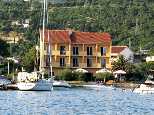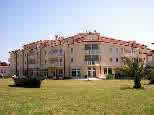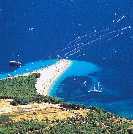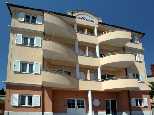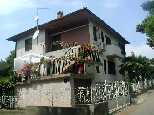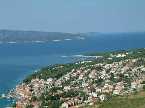

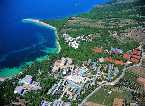

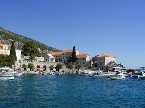
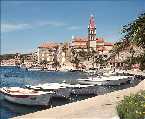

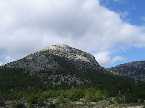


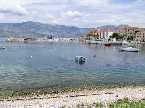
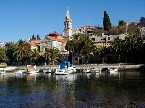

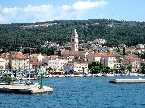
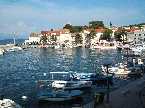
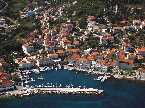
|
»
Accommodation on Brac Island
»
Picture Gallery Brac Island
Brac Island
Brac Island is one of 1.185 islands which constitute the most indented coastline of the Mediterranean. It is the highest Croatian island - its peak, Vidova Gora (or Mount St. Vid), stands at 778 m above sea level. Far away Jabuka Island can be seen from Vidova Gora during good visibility. Brac Island belongs to the Central Dalmatian group of islands. Approximately 40 km in length, in average 10 to 12 km wide, and a total area of 395 km², makes it the third largest island in the Adriatic Sea. It is one of the warmest and sunniest islands of the Adriatic Sea. Its succession of numerous coves and beaches offers bathers and sailors a unique paradise. The most famous of Adriatic beaches, Zlatni rat, is set in the southern part of the island. ACI Marina is situated in the most protected harbour in Milna, offering sea craft safe harbour. Approximately 20 settlements are located on the island with an estimated population of 15,000 inhabitants. Historic and cultural monuments are witness to uninterrupted human settlement on the island dating way back to antique times. Today, Brac is an island of tourism, stock farming, fishing, stone masonry, olive growing and wine production. The island is renowned for its wine, olive oil and lamb. Tourism is one of the island’s primary activities, directly benefiting from the local airport which connects the island to a variety of European destinations.
Brac Island is composed of a solid limestone and dolomite base. Widely renowned throughout the world, stone from Brac has been used in the construction of some of the most famous buildings in the world, including Diocletian's Palace in Split and the White House in Washington – just to mention a couple.
The Island is connected to the mainland by daily ferry (Supetar – Split, Sumartin – Makarska) and catamaran (Bol – Split) services. During Summer there is an air service as well. Private flights are available throughout the year.
The origin of the island’s name – Brac, has not been fully established. It is thought that the name originates from the Illyrian word brentos, or deer, in consideration of the fact that the Ancient Greek name for the island was Elaphusa, which stems from the word elaphos – once again, deer. Prehistoric paintings in Kopacina Cave bear witness to the existence of deer on the island in prehistoric times.
Brac enjoys a Mediterranean climate, marked by fairly moderate winters and warm summers cooled by a pleasant south-westerly wind (maestral), which alleviates the daytime humidity. Most common winds during the winter are: the cold and dry bura (NE) and warm and humid jugo (SE). During the summer: maestral (SW).
Supetar: Supetar is situated at the base of a horse-shoe shaped cove. Supetar fascinates with its simplicity. Everything here is close at hand and made to measure: restaurants, shops, banks, post offices, markets, cinema, library, galleries, health care services, various sports facilities... Your stay will be made even more pleasurable thanks to free concerts, theatrical shows, folkloric festivals and numerous other events which are organized as part of the Supetar Summer of Culture.
With great connections to Split via a direct ferry line (more than 14 trips daily during the summer), Supetar is an ideal destination for all those who which to enjoy in the rich cultural heritage and natural beauty of the Central Dalmatian mainland (Diocletian's Palace, Trogir, Salona, Klis, Vranjaca Cave, Cetina Canyon, Krka Falls, Šibenik Cathedral...), whle at the same time being able to enjoy in the charms of a small island town.
Milna: situated at the foot of a deep blue bay on the most southwestern extremity of Brac Island, marked by crystal clear seawater, sunbathed beaches and deep shadows cast by century old pine forests, is the township of Milna. Built in Brac stone the colour of aged ivory, facing the sun and sunsets, protected from vicious winds yet refreshed by the afternoon summer maestral, Milna offers pacifying sanctuary for people and sea craft alike. This miniature oasis of a Mediterranean lifestyle (protected from the elements and a nervous modern lifestyle) is reminiscent of a rich seafaring, fishing and wine growing history, evoked by an almost urban fabric interwoven with old sea captains’ palaces and modest houses of fishermen and labourers. Unforgettable views to the bay and deep Milna bay inlet are generously forthcoming from the entire length of the winding seaside promenade (lined with ancient palm trees), as well as from surrounding foothills, a botanical paradise of its own accord – composed of olive groves and vineyards, lavender and sage.
Bol: the oldest town on the Brac coastline, is situated in the southern part of the island. Spacious sandy and pebble beaches extending in the order of ten kilometres, as well as numerous freshwater springs have made Bol the primary tourist oasis on the island of Brac. Besides kilometres of wonderful beaches, Bol is most famous for the Zlatni Rat Beach, considered by many to be the most beautiful beach in the entire Adriatic. Rising over Bol is the Bolska kruna mountain cap, Koštilo Illyrian ruins and Vidova gora, the highest peak in the entire Adriatic archipelago. Situated only 15 kilometres away from the international tourist - sport airport of ‘Brac’, with fast lines to the mainland, as well as a ferry connection from Supetar, Bol is a very reachable corner of the world that captivates with its crystal clear seas, preserved environment and untainted beauty of stone island houses.
Numerous archaeological findings and monuments are witness to a rich history dating back to ancient times - a roman aqueduct, tombstone stelae and reliefs, old Christian sarcophagi, an 11th century pre-Romanesque church of St. John and Tudor, 12th century bishop's residence, a 15th century church of Our Lady of Mercy, fortified gothic summer house from the 15th century, a renaissance-baroque palace with a valuable gallery of contemporary Croatian art ‘Branislav Dešković’ from the 17th century, as well as the local church of Our Lady of Carmel dating from the 18th century. The establishment of the Dominican community in 1462 AD as well as the construction of a monastery in 1475 (which still showcases collections of prehistoric and antique naval archaeology, Roman and early Croatian sculpture and architecture, a numismatic collection and a collection of church artefacts) greatly influenced the development of the spiritual and cultural life of Bol. The museum houses a painting of the Madonna with the Child and Saints, which is the work of a Venetian painter, Tintoretto, from 1563.
Besides high-quality hotels, Bol also offers more than 2.500 beds in private accommodation. Besides numerous small restaurants by the sea, discothèques and clubs, Bol also offers relaxing moments with Dalmatian klape (traditional harmony-singing groups), performances by famous opera singers, theatre productions, as well as art exhibitions by famous artists. As the largest tourist centre on the island of Brac, Bol offers guests twenty or so tennis courts, a large tennis stadium with 1.820 seats where the elite of the tennis world gather every year. Bol is also ideal for fans of indoor football, volleyball, basketball, bicycling, extreme sports, which, by the way, are becoming increasingly popular (trekking, free climbing, paragliding…), as well as water sports, particularly diving and wind-surfing. Due to extremely favourable wind conditions during the summer, Bol is one of the most famous surfer destinations of the Adriatic.
|


